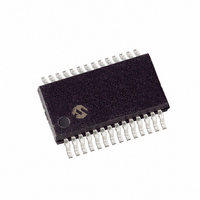PIC18F25J10-I/SS Microchip Technology, PIC18F25J10-I/SS Datasheet - Page 33

PIC18F25J10-I/SS
Manufacturer Part Number
PIC18F25J10-I/SS
Description
IC PIC MCU FLASH 16KX16 28SSOP
Manufacturer
Microchip Technology
Series
PIC® 18Fr
Datasheets
1.PIC16F616T-ISL.pdf
(8 pages)
2.PIC18F24J10-ISO.pdf
(368 pages)
3.PIC18F24J10-ISO.pdf
(6 pages)
4.PIC18F24J10-ISO.pdf
(6 pages)
5.PIC18F24J10-ISO.pdf
(12 pages)
6.PIC18LF24J10-ISS.pdf
(32 pages)
7.PIC18F45J10-IPT.pdf
(362 pages)
Specifications of PIC18F25J10-I/SS
Core Size
8-Bit
Program Memory Size
32KB (16K x 16)
Peripherals
Brown-out Detect/Reset, POR, PWM, WDT
Core Processor
PIC
Speed
40MHz
Connectivity
I²C, SPI, UART/USART
Number Of I /o
21
Program Memory Type
FLASH
Ram Size
1K x 8
Voltage - Supply (vcc/vdd)
2.7 V ~ 3.6 V
Data Converters
A/D 10x10b
Oscillator Type
Internal
Operating Temperature
-40°C ~ 85°C
Package / Case
28-SSOP
Controller Family/series
PIC18
No. Of I/o's
21
Ram Memory Size
1KB
Cpu Speed
40MHz
No. Of Timers
3
Processor Series
PIC18F
Core
PIC
Data Bus Width
8 bit
Data Ram Size
1 KB
Interface Type
SPIC, I2C, EUSART
Maximum Clock Frequency
40 MHz
Number Of Programmable I/os
21
Number Of Timers
3
Maximum Operating Temperature
+ 85 C
Mounting Style
SMD/SMT
3rd Party Development Tools
52715-96, 52716-328, 52717-734, 52712-325, EWPIC18
Development Tools By Supplier
PG164130, DV164035, DV244005, DV164005, PG164120, DM183022, DM183032, DV164136
Minimum Operating Temperature
- 40 C
On-chip Adc
10 bit, 10 Channel
Package
28SSOP
Device Core
PIC
Family Name
PIC18
Maximum Speed
40 MHz
Operating Supply Voltage
5 V
Lead Free Status / RoHS Status
Lead free / RoHS Compliant
For Use With
AC162074 - HEADER INTRFC MPLAB ICD2 44TQFPMA180011 - MODULE PLUG-IN 18F25J10 28SOICAC162067 - HEADER INTRFC MPLAB ICD2 40/28PAC164331 - MODULE SKT FOR 28SSOP 18F45J10XLT28SS-1 - SOCKET TRANSITION ICE 28SSOP
Eeprom Size
-
Lead Free Status / Rohs Status
Details
Available stocks
Company
Part Number
Manufacturer
Quantity
Price
Part Number:
PIC18F25J10-I/SS
Manufacturer:
MICROCHIP/微芯
Quantity:
20 000
- PIC16F616T-ISL PDF datasheet
- PIC18F24J10-ISO PDF datasheet #2
- PIC18F24J10-ISO PDF datasheet #3
- PIC18F24J10-ISO PDF datasheet #4
- PIC18F24J10-ISO PDF datasheet #5
- PIC18LF24J10-ISS PDF datasheet #6
- PIC18F45J10-IPT PDF datasheet #7
- Current page: 33 of 362
- Download datasheet (6Mb)
3.0
The PIC18F45J10 family devices provide the ability to
manage power consumption by simply managing clock-
ing to the CPU and the peripherals. In general, a lower
clock frequency and a reduction in the number of circuits
being clocked constitutes lower consumed power. For
the sake of managing power in an application, there are
three primary modes of operation:
• Run mode
• Idle mode
• Sleep mode
These modes define which portions of the device are
clocked and at what speed. The Run and Idle modes
may use any of the three available clock sources
(primary, secondary or internal oscillator block); the
Sleep mode does not use a clock source.
The
power-saving features offered on previous PIC
microcontrollers. One is the clock switching feature,
offered in other PIC18 devices, allowing the controller
to use the Timer1 oscillator in place of the primary
oscillator. Also included is the Sleep mode, offered by
all PIC microcontrollers, where all device clocks are
stopped.
3.1
Selecting a power-managed mode requires two
decisions: if the CPU is to be clocked or not and which
clock source is to be used. The IDLEN bit
(OSCCON<7>) controls CPU clocking, while the
SCS1:SCS0 bits (OSCCON<1:0>) select the clock
source. The individual modes, bit settings, clock
sources and affected modules are summarized in
Table 3-1.
TABLE 3-1:
© 2008 Microchip Technology Inc.
Sleep
PRI_RUN
SEC_RUN
RC_RUN
PRI_IDLE
SEC_IDLE
RC_IDLE
Note 1:
Mode
power-managed
POWER-MANAGED MODES
Selecting Power-Managed Modes
IDLEN reflects its value when the SLEEP instruction is executed.
IDLEN<7>
POWER-MANAGED MODES
N/A
N/A
N/A
0
1
1
1
OSCCON bits
(1)
modes
SCS1:SCS0<1:0>
N/A
10
01
11
10
01
11
include
several
Clocked
Clocked
Clocked
Module Clocking
CPU
Off
Off
Off
Off
®
Peripherals
Clocked
Clocked
Clocked
Clocked
Clocked
Clocked
PIC18F45J10 FAMILY
Off
3.1.1
The SCS1:SCS0 bits allow the selection of one of three
clock sources for power-managed modes. They are:
• the primary clock, as defined by the
• the secondary clock (Timer1 oscillator)
• the internal oscillator
3.1.2
Switching from one power-managed mode to another
begins by loading the OSCCON register. The
SCS1:SCS0 bits select the clock source and determine
which Run or Idle mode is to be used. Changing these
bits causes an immediate switch to the new clock
source, assuming that it is running. The switch may
also be subject to clock transition delays. These are
discussed in Section 3.1.3 “Clock Transitions and
Status Indicators” and subsequent sections.
Entry to the power-managed Idle or Sleep modes is
triggered by the execution of a SLEEP instruction. The
actual mode that results depends on the status of the
IDLEN bit.
Depending on the current mode and the mode being
switched to, a change to a power-managed mode does
not always require setting all of these bits. Many
transitions may be done by changing the oscillator
select bits, or changing the IDLEN bit, prior to issuing a
SLEEP instruction. If the IDLEN bit is already
configured correctly, it may only be necessary to
perform a SLEEP instruction to switch to the desired
mode.
FOSC1:FOSC0 Configuration bits
None – All clocks are disabled
Primary – HS, EC;
this is the normal full-power execution mode
Secondary – Timer1 Oscillator
Internal Oscillator
Primary – HS, EC
Secondary – Timer1 Oscillator
Internal Oscillator
Available Clock and Oscillator Source
CLOCK SOURCES
ENTERING POWER-MANAGED
MODES
DS39682D-page 31
Related parts for PIC18F25J10-I/SS
Image
Part Number
Description
Manufacturer
Datasheet
Request
R

Part Number:
Description:
Manufacturer:
Microchip Technology Inc.
Datasheet:

Part Number:
Description:
Manufacturer:
Microchip Technology Inc.
Datasheet:

Part Number:
Description:
Manufacturer:
Microchip Technology Inc.
Datasheet:

Part Number:
Description:
Manufacturer:
Microchip Technology Inc.
Datasheet:

Part Number:
Description:
Manufacturer:
Microchip Technology Inc.
Datasheet:

Part Number:
Description:
Manufacturer:
Microchip Technology Inc.
Datasheet:

Part Number:
Description:
Manufacturer:
Microchip Technology Inc.
Datasheet:

Part Number:
Description:
Manufacturer:
Microchip Technology Inc.
Datasheet:











